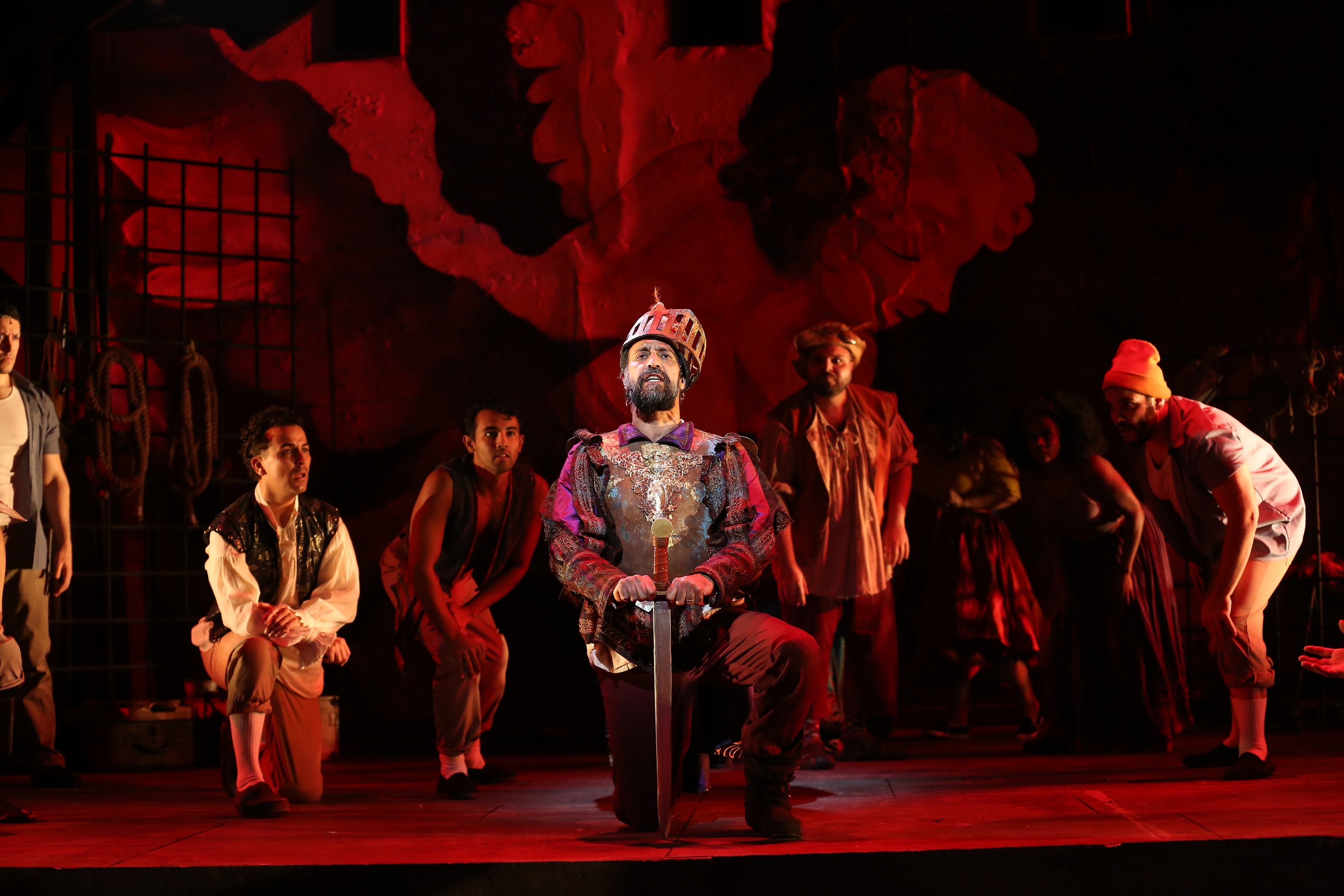
August 23 – September 5
by Dale Wasserman
music by Mitch Leigh
lyrics by Joe Darion
directed by Mark Lamos
SETTING
A prison in the city of Seville and various places in the imagination of Miguel de Cervantes.
ORIGINAL RUN DATES
September 25 – October 13, 2018
Original Production staged by Albert Marre
Originally produced by Albert W. Selden and Hal James
Man of La Mancha is presented by arrangement with Tams-Witmark Music Library, Inc.,
560 Lexington Avenue, New York, New York 10022
2021 SEASON SPONSORS
Eunice & David Bigelow Foundation
PRODUCTION SPONSOR
Barbara Samuelson
SPECIAL FUNDING
Maureen & Edwin Schloss
PRODUCTION SPONSORS
Barbara & John Samuelson
Barbara & John Streicker
PRODUCTION PARTNERS
Carol & Peter Seldin
EDUCATION SPONSORS
The Graham Foundation of Connecticut
The David & Geri Epstein Private Foundation
CORPORATE PRODUCTION SPONSOR
Bank of America
CORPORATE PRODUCTION PARTNER
Cohen & Wolf P.C., Attorneys at Law

by Mark Lamos
August 2018
Dear Friends,
Man of La Mancha began its unusual and successful life first as a program for live television’s “golden age,” an era when classic plays, great opera productions, classical ballets, and Leonard Bernstein’s Young People’s Concerts were routinely broadcast “live from New York.” The dramas featured major stars of stage and screen along with prominent writers and directors of the era. In 1959, the “DuPont Show of the Month” presented Dale Wasserman’s teleplay, “I, Don Quixote,” based on Miguel de Cervantes’ 1,000 page 17th century Spanish novel, to 20 million American viewers. Thus the seeds of the musical were planted in a Manhattan television studio, and the speech that would become its most famous song, “The Impossible Dream,” was almost cut before air time — twice!— until the actor playing the title role (the great Lee J. Cobb) insisted it be reinstated.
The show began its life as a musical just up the road from Westport Playhouse in 1965. The refurbished Goodspeed Opera House in East Haddam, Connecticut had opened its doors as a home for musicals just three seasons earlier. Wasserman’s retooled and retitled Man of La Mancha, now with music by Mitch Leigh and lyrics by Joe Darion, would be its first world premiere. In his 2003 memoir The Impossible Musical, Wasserman perhaps arguably suggested that, “All of [Goodspeed Opera’s] success and fame, stretching many decades now, is due to a venturesome new musical that opened in the summer of 1965 called Man of La Mancha.”
When the show was ready for New York, the producers decided it would be wiser to place it closer to the flourishing “downtown” scene in Greenwich Village, with its counter-culture 1960s energy, instead of the more obviously commercial uptown Broadway. They felt its story of one man fighting the odds, ennobling all he sees, and dreaming impossible dreams, was more suited to a less upscale — and more youthful and daring — part of Manhattan. The thrust staging, unusual for a big musical in New York, intimately connected audiences to the turbulent action on stage.
La Mancha was on the fault lines. In many ways, it pointed the way toward approaching serious issues in musical theater. In just a few seasons A Chorus Line and Company would appear, continuing to change the popular perception of what the genre should be. “[La Mancha] looked back to the golden age of musicals such as South Pacific and Carousel… while it simultaneously celebrated the value of eccentricity, originality, and abandon,” writes theater scholar Robert Sennet.
Man of La Mancha has since been performed in almost fifty countries — a story so beloved and universal that it resonates around the world. I hope it speaks to you tonight, and that you might even linger on its relevance today, with a prison incarceration problem of massive scale and a surging mass of desperate humanity attempting to cross our borders to make impossible dreams come true.
Additional Video Editing
Stephen Emerick
Sound Board Mixer
Emery Roth
Assistant Scenic Design
Joo Kim, Anton Volovsek
Assistant Costume Design
Asa Benally
Assistant Lighting Design
Breana McGlocking
Production Assistants
Page Tazewell, Katie Cecil Cairns, Elisabeth Barnes-Flint
Dresser
Danny Smooke
Associate Producer / Director of Production
David Dreyfoos
Technical Director / Associate Director of Production
RJ Romeo
Company Manager
Bruce Miller
Head Stage Carpenter / Flyman
Anthony Servetas
Head Electrician / Light Board Operator
Bob McDevitt
Head Sound / Sound Board Operator
Jon Damast
Head Shop Carpenter
Jason Thompson
Carpenter
Scott Trichka
Wardrobe Supervisor
Lisa Ficco
Scenic Artist
Jess Ploszaj
Carpentry / ATD Fellow
Aaron Moss Cohen
Act I
Overture
Orchestra
Man of La Mancha
Don Quixote, Sancho
DULCINEA
Don Quixote, Muleteers
I’m Only Thinking of Him
Antonia, Padre, Housekeeper
We're Only Thinking Of Him – Antonia, Carasco, Padre, Housekeeper
The Missive – Sancho
I Really Like Him – Sancho
What Does He Want Of Me? – Aldonza
Little Bird, Little Bird – Anselmo, Pedro, Muleteers
Barber's Song – Barber
Golden Helmet Of Mambrino – Don Quixote, Sancho, Barber, Muleteers
To Each His Dulcinea – Padre
The Impossible Dream (The Quest) – Don Quixote
Act II
The Combat
Orchestra
The Dubbing/Knight of the Woeful Countenance
Innkeeper, Don Quixote, Aldonza, Sancho
The Abduction
Anselmo, Pedro, Fermina
The Impossible Dream (The Quest) Reprise
Don Quixote
Man of La Mancha Reprise
Don Quixote
Aldonza
Aldonza
A Little Gossip
Sancho
Dulcinea Reprise
Aldonza
The Impossible Dream (The Quest) Reprise
Aldonza & Don Quixote
Man of La Mancha (I, Don Quixote) Reprise
Don Quixote, Sancho, Aldonza
The Psalm
Padre
Finale
Company
About Miguel de Cervantes
by David Kennedy and Liam Lonegan
Born outside of Madrid in 1547, Miguel de Cervantes Saavedra, considered by many to be the inventor of the modern novel, is regarded as the greatest writer in the Spanish language. His most famous work, Don Quixote, has been translated into more languages than any other book except the Bible. While the adventures of the novel’s protagonist are many, Cervantes’ real-life adventures give the title character a run for his money. In 1570 Cervantes enlisted in a regiment of the Spanish Navy Marines, and was wounded three times in October 1571 in the victory over the Ottoman fleet at the Battle of Lepanto. After his recovery, he was based mainly in Naples for the following three years, making expeditions from there to places throughout the Mediterranean. It was in 1575, while sailing from Italy to Barcelona, that his ship was attacked, and he was captured by Barbary pirates.
[This] five-year captivity left an indelible impression… the traumatic experience continuously speaks through [Cervantes’] work.
MARIA ANTONIA GARCÉS
Imprisoned in North Africa and kept as a slave, he made four unsuccessful escape attempts before he was ransomed by his parents in 1580 and sent back to Spain. According to Cervantes scholar Maria Antonia Garcés, this “five-year captivity in Algiers left an indelible impression on his fiction. From the first works written after his liberation…this traumatic experience continuously speaks through his work.”
That was not the last time Cervantes was imprisoned. Returning to Spain, he attempted to live a fairly modest life as a tax collector in the Kingdom of Granada. But, after successfully gathering funds owed the Crown, he deposited the money with a Sevillian banker who went bankrupt soon thereafter, leaving Cervantes’ accounts unpaid. Though he was sent to jail for only several months, it proved to be a turning point in his life. Cervantes later remarked that it was at this time he had the idea to write Don Quixote, which follows the adventures of a country nobleman named Alonso Quixano who, exhilarated by romantic stories of old, adopts the name Don Quixote de la Mancha and sets out to revive chivalry, right wrongs, and restore justice to the world. The musical Man of La Mancha draws from this period of Cervantes’ life, staging his invention of the Quixote legend while he is imprisoned in Seville.
Though Cervantes is known primarily for Don Quixote, it is said that, above all, he wanted to be a dramatist. He penned sixteen dramatic works: eight full-length plays and eight short farces. Most of them are lost to history, but two survive. El Trato de Argel details his experiences in pirate captivity and La Numancia depicts the tragic and violent events of the siege of Numantia by the Romans.
During his later years, Cervantes did not tire of his literary pursuits. In the last three years of his life, he published two novels and a collection of tales. He had just finished a final adventure novel entitled Los Trabajos de Persiles y Sigismunda when he died in Madrid in 1616 of what modern scholars believe was type-2 diabetes. Despite the fact that Don Quixote was a success in his lifetime, and he was hard at work until the day he died, his financial issues never ceased. Cervantes died penniless, but his imagination will live on forever.
